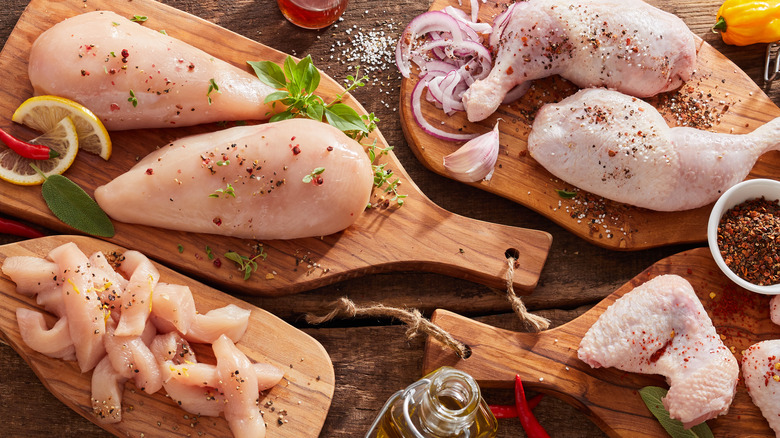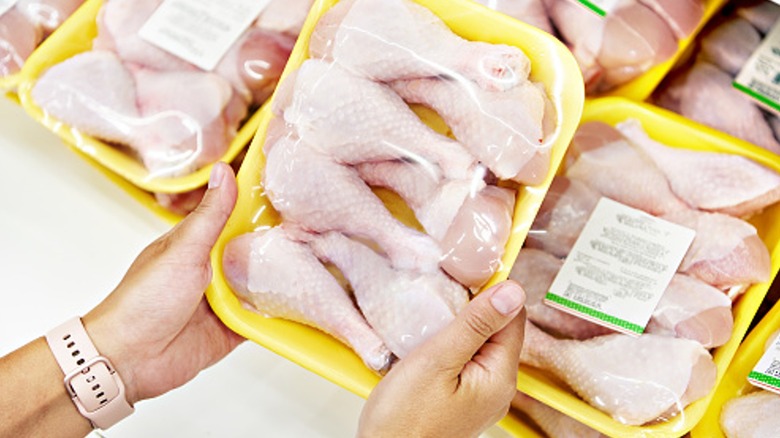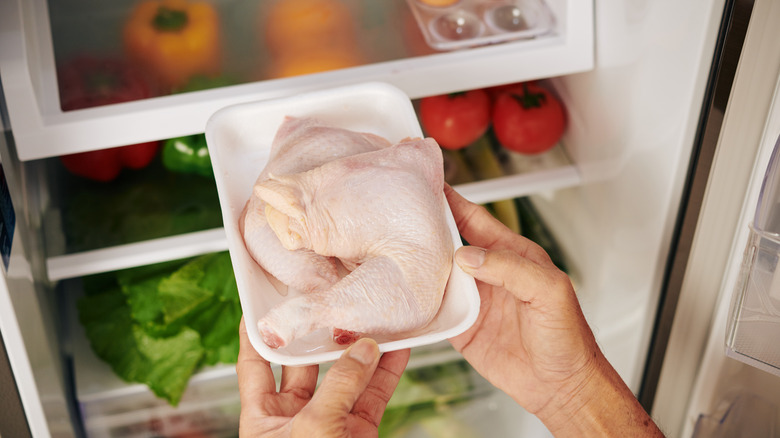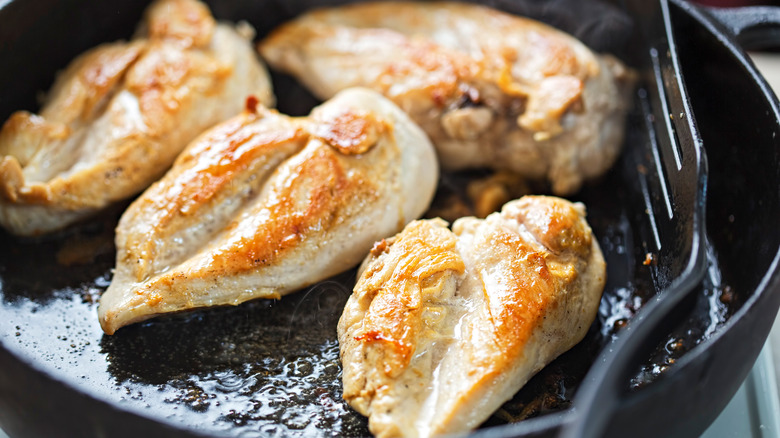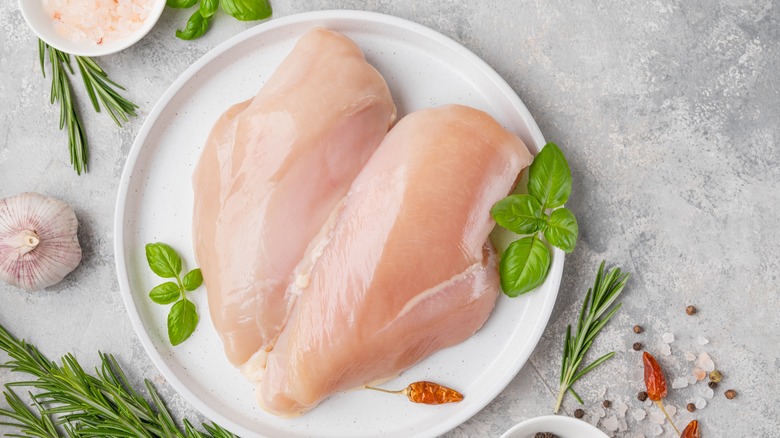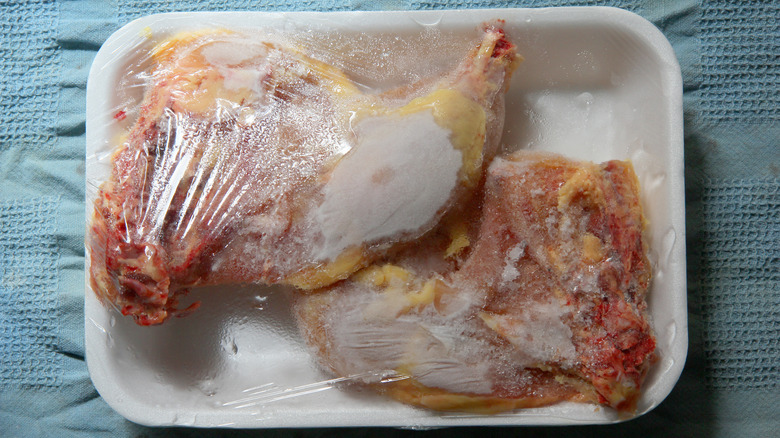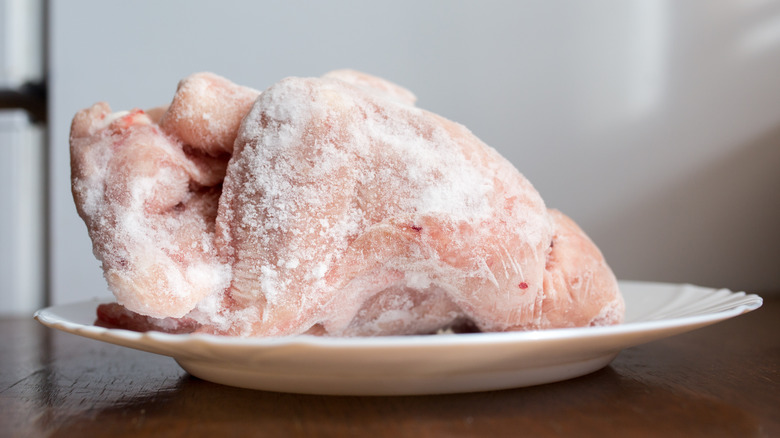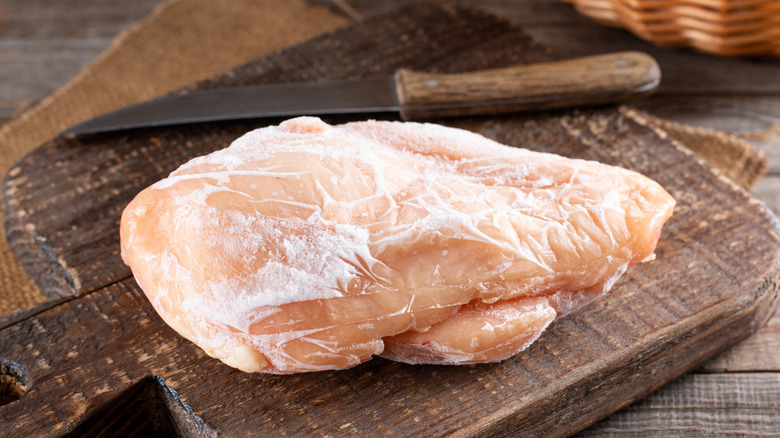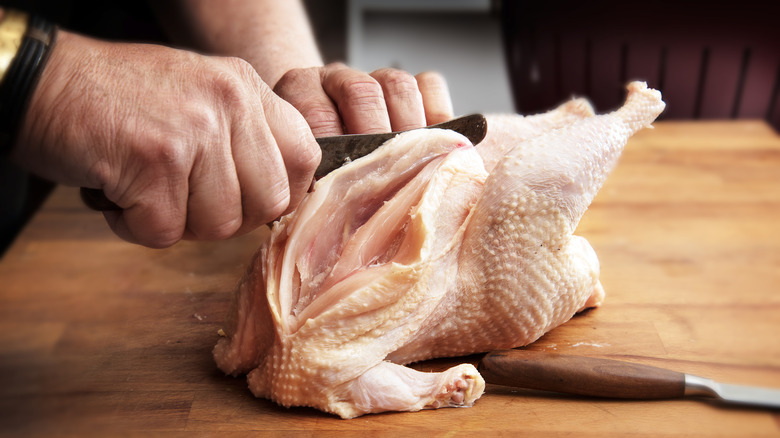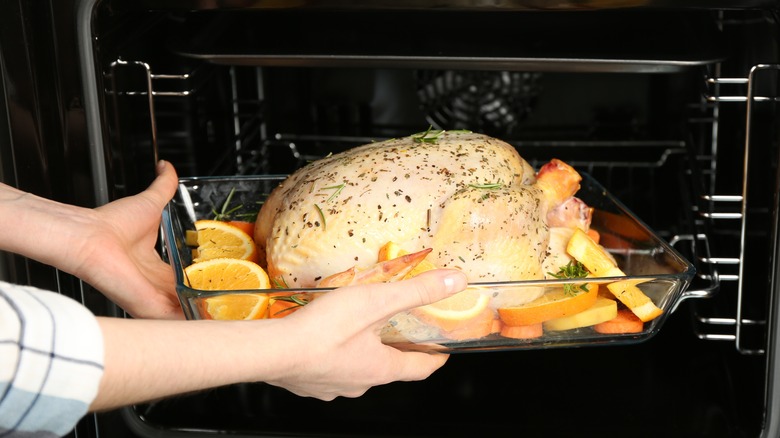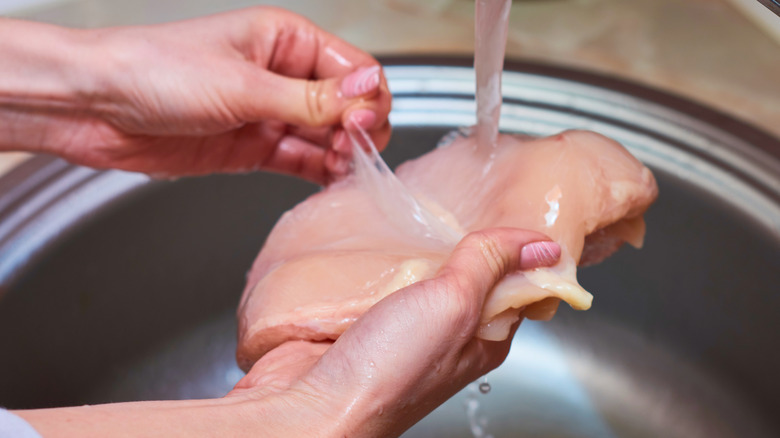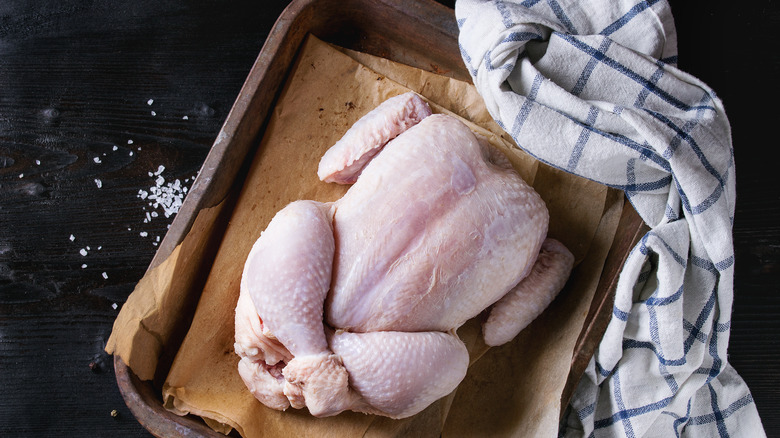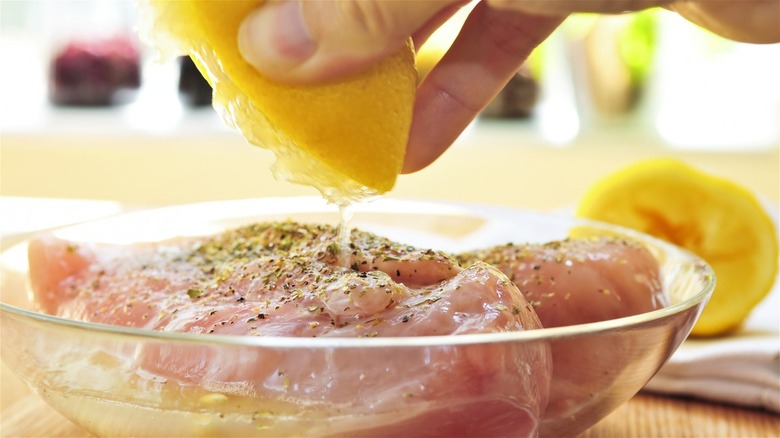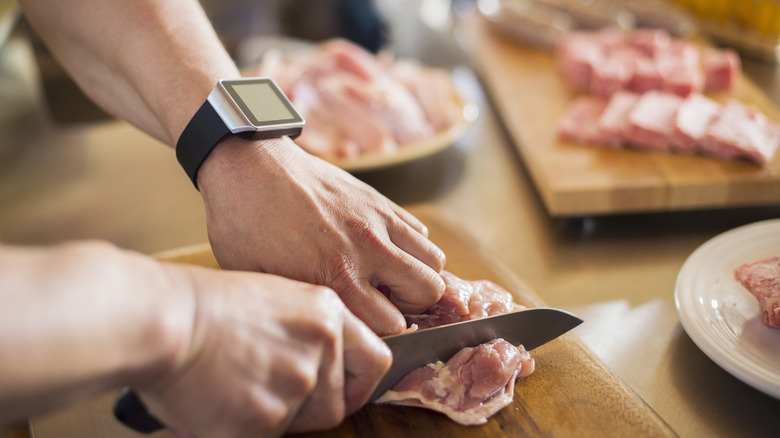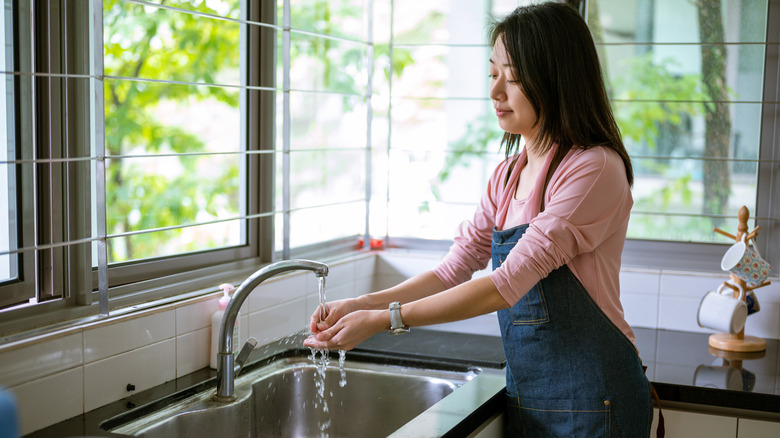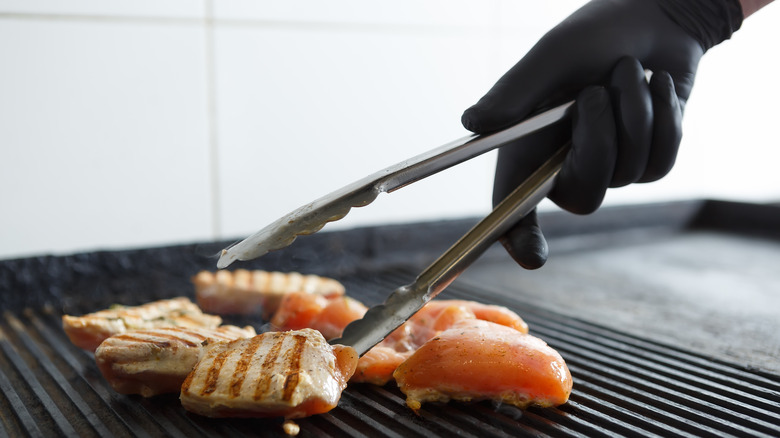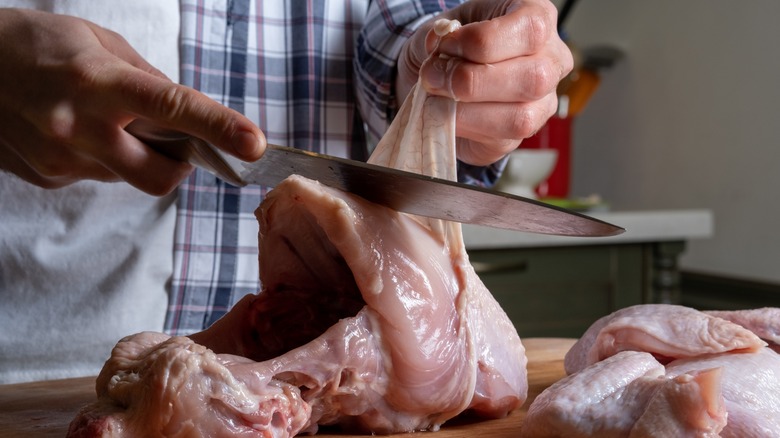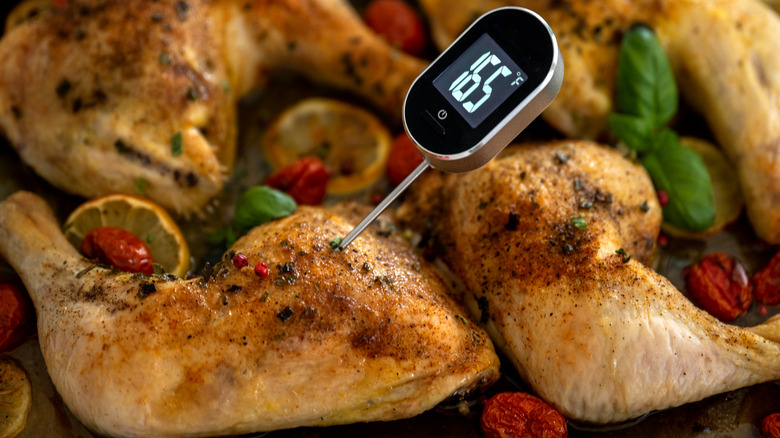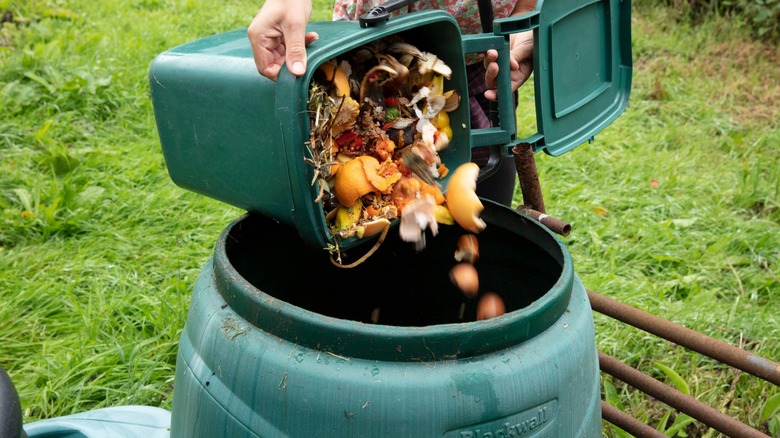18 Mistakes You Need To Stop Making With Raw Chicken
To make delicious recipes such as chicken cacciatore, chicken pot pie, or chicken curry at home, you'll need raw chicken. Whether you're purchasing a whole chicken from the grocery store, or a package of breasts, wings, legs, or thighs, you need to be careful when working with the uncooked meat. According to the Centers for Disease Control and Prevention, raw chicken can be contaminated with Salmonella, Campylobacter, or Clostridium perfringens bacteria.
While you likely know that you shouldn't eat raw chicken — as the aforementioned bacteria can cause severe food poisoning — there are other less obvious mistakes that many people make when handling or cooking poultry. These errors can put your health, or the health of others, at risk. They can also have a negative impact on the way the finished meal turns out. If you want to avoid these potentially dangerous and disappointing mistakes, keep reading.
1. Placing it directly into your cart or shopping bag at the grocery store
One raw chicken mistake can occur before you even leave the grocery store. After selecting your desired package of chicken, you should avoid placing it directly into your grocery cart or shopping bag. Doing so can increase the risk of contaminating your other groceries with raw chicken juice, which could cause food poisoning.
Instead, put the chicken in a disposable plastic bag. This will help contain any juices, keeping them from getting on any of the other food items in the bag or cart. If you don't take the time to do this — and you place raw chicken into a reusable shopping bag — the bacteria can remain in the bag and contaminate your other goods.
2. Not storing it properly in the refrigerator
Another raw chicken mistake can happen as soon as you return from the supermarket when you are putting your items away. Where you store raw chicken in the refrigerator matters, so don't simply place it on whichever shelf has space. Raw chicken — and any other raw meats and seafood — should always be stored on the bottom shelf in the refrigerator. This way, if any juice leaks out of the package, it won't drop onto your other items.
In addition to storing raw chicken on the bottom shelf, take steps to limit the amount of juices dripping out of your chicken container. Store the chicken in a leak-proof container, wrap the package with additional plastic wrap, or put it in a plastic grocery bag.
3. Not cooking or freezing the chicken soon enough
Once you bring a package of raw chicken home from the grocery store, you should plan to cook it quickly. If you leave the chicken in the fridge for longer than one to two days, you're increasing the risk of the chicken spoiling and making someone sick.
If you're not going to be able to cook the chicken you purchased within two days, then it should be stored in the freezer. When properly stored, frozen raw chicken pieces will remain safe to use for up to nine months. A whole chicken can last up to a year in the freezer.
4. Not knowing how to tell if the chicken has gone bad
Cooking spoiled chicken is a big mistake. While the process of cooking does kill some of the dangerous surface bacteria, other bacteria will remain. For this reason, it's essential to learn how to tell if your chicken has gone bad.
If you notice an odd odor, the chicken feels slimy, or the coloring looks different, it's best to assume that it's not safe to eat. Any changes in texture, smell, or appearance are signs of spoilage. Packages of chicken from the grocery store should have a "use by" date. While this isn't an expiration date, it can give you some guidance.
5. Freezing the chicken in its original packaging
If you put packages of chicken from the grocery store directly into your freezer, then you've been making a mistake. While freezing it in its packaging isn't bad in the short term, it's not the best method for long-term storage. Packaging from the store often leaves room for a lot of air around the chicken, making it more likely for your chicken to develop freezer burn.
The best way to freeze chicken is to wrap it tightly with a few layers of freezer paper or plastic wrap. Next, wrap the chicken in foil, then place the whole thing in a freezer-safe bag with as much air removed as possible. If you have a vacuum packaging system that will remove all of the air, that can also help prevent freezer burn, thereby ensuring that your chicken will taste good when thawed and cooked.
6. Not choosing a safe way to thaw it
One of the biggest food safety mistakes you can make with frozen raw chicken is not thawing it properly. Many people leave chicken and other meats out on the counter for several hours to let them defrost. Others — especially when they are in a rush — will put the chicken container into hot water to speed up the thawing process. Both of these methods of thawing chicken could be putting you or others at risk of food poisoning.
The reason they are considered unsafe has to do with something that the United States Department of Agriculture calls the "danger zone."This refers to the temperature range between 40 and 140 degrees Fahrenheit. When the temperature of the chicken falls within this range, it is more likely for bacteria to multiply, thus increasing your risk of contracting a foodborne illness. When thawing chicken on the counter or in hot water, parts of the chicken will defrost more quickly than others, meaning that they'll fall into the danger zone when other parts of the chicken are still frozen.
Instead, try moving your raw chicken container to the refrigerator the night before you'll need it (or a bit earlier if you're cooking a whole chicken). This method will allow it to thaw safely and evenly, keeping parts of it from reaching the danger zone. If you need to thaw your chicken a bit more quickly, you can place it in cold water. Replace the water about every 30 minutes to ensure that it stays cool enough to avoid the danger zone.
7. Not leaving enough time to cook frozen chicken
If you forget to thaw your frozen chicken, you don't always have to come up with an alternative plan for dinner. In some cases, you can successfully cook frozen chicken. However, if you assume that it will cook as quickly as fresh or thawed chicken, then you're making another mistake.
If you plan on cooking frozen chicken, assume that it will take about one-and-a-half times as long to cook as your recipe calls for. If the recommended cooking time is 30 minutes, this means you should plan for it to take 45 minutes; if the recipe calls for one hour in the oven, leave one-and-a-half hours for it to cook. When cooking frozen chicken, you might find that it will taste better when coated with some sauce. The sauce will help ensure that it turns out moist and tender, rather than dry and chewy.
8. Not knowing how to properly cut a whole raw chicken
Buying a whole chicken can be more cost-effective than buying separate packages of different cuts. While there are many delicious recipes for cooking a whole chicken, there may be times when you want to cut the chicken and cook the legs, breasts, wings, and thighs separately. Buying a whole chicken and cutting the pieces off yourself will also leave you with the carcass, which you can use to make homemade chicken stock or broth.
To cut a whole chicken, you'll need a sharp chef's knife and some kitchen shears. After patting the chicken dry using a paper towel, make sure it is breast side up on your cutting board. The first step is to methodically remove the legs. After cutting off the legs, you'll turn the chicken on each side to remove each wing. Finally, you'll remove the breasts. The process takes some getting used to, but you can get the hang of it with practice.
9. Moving chicken directly from the refrigerator to the oven
While the temperature of your raw chicken could reach the danger zone if it's left out on the counter for too long, it's also not a good idea to place chicken in the oven immediately after pulling it out of the fridge. When the chicken comes out of the fridge, it's obviously going to be very cold. It's unlikely to cook evenly if placed in the oven right away; the inside will remain cooler and won't cook as quickly as the rest. This will either leave you with an undercooked center or an overcooked outside.
The simple solution to this problem is to take the chicken out of the fridge a few minutes before you plan to cook it. We recommend removing it around 15 to 20 minutes before your desired cook time.
10. Rinsing it before cooking it
Many people were taught to rinse raw chicken before cooking it. They were taught that this was a necessary step to remove blood or grime that remained from the process of animal slaughter. However, while this step might have been important years ago, it isn't necessary anymore. The chicken you purchase at the grocery store is washed before it is packaged.
Beyond simply being unnecessary, rinsing poultry in the kitchen sink can actually be dangerous. It increases the chances of cross-contamination. If you wash your raw chicken, you risk spreading its raw juices throughout your kitchen sink, or surrounding areas.
11. Not drying it
While washing raw chicken is unnecessary and can increase the spread of bacteria, you should still dry your raw chicken before cooking begins. If it's too moist, more liquids will be released during the cooking process. This can result in soggy — not nice and crispy — chicken.
The reason chicken can be so moist is that manufacturers often wash it with saline to ensure it looks nice and fresh on the shelves at the store. Simply pat the chicken down with some paper towels before cooking it to remove this excess moisture. Just remember to put the paper towels directly into the trash can to avoid spreading bacteria.
12. Not knowing how to properly marinate the chicken
Marinating chicken can lead to multiple mistakes. The first relates to food safety. Just as chicken should never be left on the counter to defrost, it should also not be left on the counter when marinating. To avoid letting the temperature rise too high, and get into the danger zone for bacteria, leave the chicken in the fridge while it's marinating.
A similar mistake occurs when you brush your previously-used marinade over cooked chicken. There will be bacteria from the raw chicken in the sauce, so it should only be applied before the chicken is cooked. If you want extra sauce for the cooked chicken, either make a new batch or boil the remaining sauce to kill off any bacteria.
Marinades are acidic, which allows them to make the chicken nice and tender. You can marinate chicken for several hours, but don't leave it sitting in the marinade for more than a day or two, at the most. After this time, the acids in the marinade can cause the fibers of the chicken to break down so much that the meat will be turned into mush.
13. Not using a separate cutting board for raw chicken
If you use the same cutting board for raw chicken as vegetables, breads, and other foods, then you've been making a mistake — even if you wash it between uses. Cutting boards can harbor bacteria and toxins from raw meat. When you cut something else on them, some of these bacteria can transfer, causing contamination and food poisoning. To avoid this, dedicate a separate cutting board to raw meat.
However, it's still essential to clean your cutting boards properly after every use. Many cutting boards, including those made from plastic, acrylic, and glass, are dishwasher-safe. However, some bamboo, wood, and other types of cutting boards will need to be hand washed.
To sanitize your cutting boards, the USDA recommends mixing 1 gallon of water with 1 tablespoon of liquid bleach. Put the cutting board in the sink, and pour the bleach mixture over it. Let it sit for 10 minutes, then thoroughly rinse the board. Re-wash it with soap and water before your next use.
14. Not washing your hands after handling it
Not washing your hands after handling raw chicken is a serious mistake that can lead to cross-contamination. After working with raw chicken, your hands will have bacteria on them. Anything you touch after handling the raw chicken will then become contaminated with this bacteria, increasing the chances that you or someone else in your home will get a foodborne illness.
Always wash your hands after touching raw chicken. Use soap with warm water, and scrub for at least 20 seconds. The same rules apply when handling the packaging from your raw chicken, as it can also spread bacteria.
15. Using the same tools or platters for raw and cooked chicken
After grilling chicken or removing it from heat, do you put it back on the plate or platter that it was on when raw? Do you use the same tongs or spatula to serve the chicken that you were using to cook it? If you do either of these things, then you've been making a big mistake.
Using the same platters or utensils can contaminate the cooked chicken with bacteria from when it was still raw. Always get clean tools or wash the dirty ones before using them with the cooked chicken.
16. Using your hands to remove chicken skin
Many recipes call for leaving the skin on the chicken. However, if you're looking to cut more calories from your meal, then you might want to remove the skin while the chicken is still raw. Often, using only your hands to remove the skin will turn out to be a mistake.
The skin is often pretty well stuck-on to the chicken, and the chicken itself can be very slippery. Because of this, if you try to remove it using your hands, the chicken may slide out of your hands and land on the counter or the floor. Beyond the frustration of it slipping away, you'll also need to disinfect any surfaces that it comes into contact with.
Instead, score the skin using a sharp knife, so that you're able to pull it apart. Once loosened, you can use your hands to pull it off, but you might also want to use a dry paper towel to help you keep a better grip on the slippery chicken.
17. Not using a meat thermometer
The risk of food poisoning remains until the chicken is fully cooked. For this reason, it's essential to use a meat thermometer. Don't rely on the way the chicken looks; you must make sure the internal temperature has reached a safe level.
For chicken breasts or other cuts, the meat thermometer should read at least 165 degrees Fahrenheit. If you're cooking a whole chicken, the thermometer should read around 180 degrees when placed in the inner thigh. Some thermometers are designed to be left in the chicken as it cooks and can alert you when it reaches the set temperature. Instant-read thermometers will need to be put in manually to check the temperature when you think the chicken is ready.
18. Adding it to a home compost bin
Setting up a home compost bin is a great way to reduce food waste and improve the structure and quality of your soil. While several types of food scraps can be composted, others should not be added to a home compost bin. One of these food scraps is chicken.
Chicken — whether raw or cooked — will smell as it decomposes. The odor can attract pests to your garden. Additionally, the raw chicken is also likely to be contaminated with bacteria. These bacteria could contaminate the compost, and eventually, the crops you grow in it.
The only way to compost meat safely is to use a hot compost system that will kill bacteria by raising the temperature of the bin's contents. Unless you have such a system in place, or intent to set one up, then you're best leaving raw chicken out of your compost bin.
